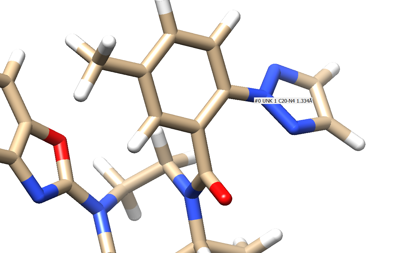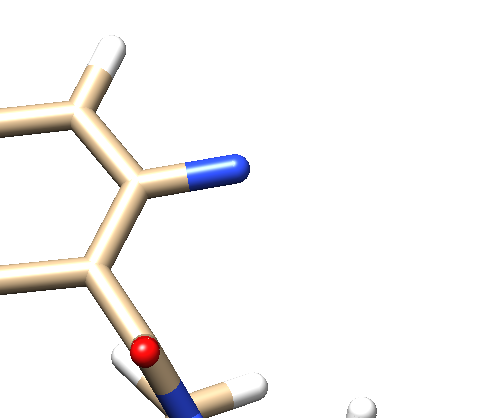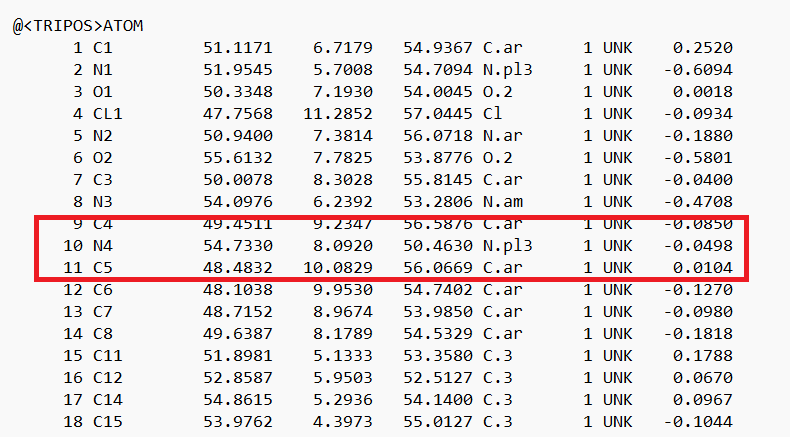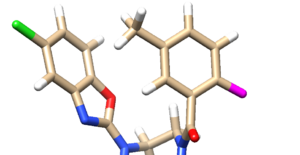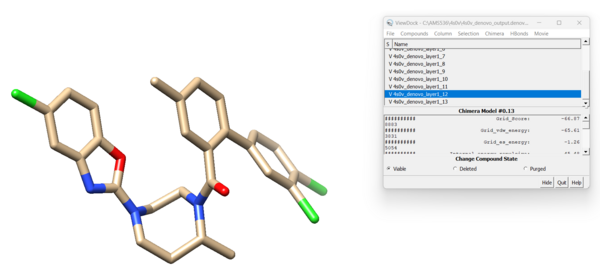2023 Denovo tutorial 1 with PDBID 4S0V
Contents
Introduction
DeNovo Design is where we are attempting to design a new ligand, usually with the hope of it binding more tightly to the protein, from scratch. There are three different ways of doing this:
- Generic DeNovo Design
- Focused Fragment Design
- DeNovo Refinement
This next tutorial will walk you through the details of each and is a continuation of the Virtual Screening tutorial. We will continue this work with #4s0v from the Protein Data Base.
Setting Up Your Environment
For this section we will need to create some more directories following this structure:
DeNovo Refinement
The DeNovo Refinement algorithm in Dock6.10 is an interesting way to determine the effects on a ligand/protein interaction by changing only part of the small molecule. The part of the ligand we want to experiment with is deleted from the structure, replaced with a dummy atom, and then run through DOCK. The program will try to find which residue can be placed in this now open position that will bind tightly to the protein.
For the ligand from #45s0v, we will be removing a terminal ring and looking at what DOCK suggests to replace it with. The steps to do this are:
1. Open the ligand minimized mol2 file we generated in the previous tutorial into Chimera. 2. Open the protein into the same session 3. Examine the binding site and choose a residue on the ligand that's pointing towards the inside of the binding site. For our protein this detailed section looks like:
We see an imidazole ring pointing towards the binding site so will choose to work with that. Select the protein and hide it from view.
4. Place your mouse over the atom connecting the ring to the rest of the ligand and note the atom and number. In this case it's N4.
5. Delete all the atoms from N4 to the end. Your ligand should now look something like:
6. Save a .mol2 file of your ligand in this configuration. Make sure to give it a new filename such as 4s0v_denovoRefinement.mol2 7. Open the .mol2 file. If you're on a UNIX system, you can use vi; if you're on a PC, you can use textedit. Locate the atom that will now be changed to a dummy atom:
8. Change the atom type to 'Du1' and the bond type to 'Du':
and save the file.
9. Open a new session in Chimera and load the modified mol2 file. The "dummy" atom should now be purple:
10. scp 4s0v_denovoRefinement.mol2 over to Seawulf and into the 012.denovoRefinement directory. From this point on we will be working on the command line.
Now that we have our .mol2 file on Seawulf we can run the DeNovo Refinement tool in DOCK6.10. We need to create an input file:
vi denovoRefinement.in
and type the following commands into it:
conformer_search_type denovo dn_fraglib_scaffold_file /gpfs/projects/AMS536/zzz.programs/dock6.10/parameters/fraglib_scaffold.mol2 dn_fraglib_linker_file /gpfs/projects/AMS536/zzz.programs/dock6.10/parameters/fraglib_linker.mol2 dn_fraglib_sidechain_file /gpfs/projects/AMS536/zzz.programs/dock6.10/parameters/fraglib_sidechain.mol2 dn_user_specified_anchor yes dn_fraglib_anchor_file 4s0v_ligand_denovo.mol2 dn_torenv_table /gpfs/projects/AMS536/zzz.programs/dock6.10/parameters/fraglib_torenv.dat dn_name_identifier 4s0v_denovo dn_sampling_method graph dn_graph_max_picks 30 dn_graph_breadth 3 dn_graph_depth 2 dn_graph_temperature 100.0 dn_pruning_conformer_score_cutoff 100.0 dn_pruning_conformer_score_scaling_factor 2.0 dn_pruning_clustering_cutoff 100.0 dn_mol_wt_cutoff_type soft dn_upper_constraint_mol_wt 1000.0 dn_lower_constraint_mol_wt 0.0 dn_mol_wt_std_dev 35.0 dn_constraint_rot_bon 15 dn_constraint_formal_charge 5 dn_heur_unmatched_num 1 dn_heur_matched_rmsd 2.0 dn_unique_anchors 1 dn_max_grow_layers 1 dn_max_root_size 25 dn_max_layer_size 25 dn_max_current_aps 5 dn_max_scaffolds_per_layer 1 dn_write_checkpoints yes dn_write_prune_dump no dn_write_orients no dn_write_growth_trees no dn_output_prefix 4s0v_denovo_output use_internal_energy yes internal_energy_rep_exp 12 internal_energy_cutoff 100.0 use_database_filter no orient_ligand no bump_filter no score_molecules yes contact_score_primary no grid_score_primary yes grid_score_rep_rad_scale 1 grid_score_vdw_scale 1 grid_score_es_scale 1 grid_score_grid_prefix ../003.gridbox/grid minimize_ligand yes minimize_anchor no minimize_flexible_growth yes use_advanced_simplex_parameters no simplex_max_cycles 1 simplex_score_converge 0.1 simplex_cycle_converge 1 simplex_trans_step 1 simplex_rot_step 0.1 simplex_tors_step 10 simplex_grow_max_iterations 250 simplex_grow_tors_premin_iterations 0 simplex_random_seed 0 simplex_restraint_min yes simplex_coefficient_restraint 10 atom_model all vdw_defn_file /gpfs/projects/AMS536/zzz.programs/dock6.10/parameters/vdw_de_novo.defn flex_defn_file /gpfs/projects/AMS536/zzz.programs/dock6.10/parameters/flex.defn flex_drive_file /gpfs/projects/AMS536/zzz.programs/dock6.10/parameters/flex_drive.tbl
To run your file simply type:
dock6 -i denovoRefinement.in -o denovoRefinement.out
Once the job has completed you will see the following new files in your directory:
- 4s0v_denovo_output.anchor_1.root_layer_1.mol2
- 4s0v_denovo_output.denovo_build.mol2
- denovoRefinement.out
scp the two .mol2 files over to your local computer. Open a new session in Chimera. To view the new residues that DOCK added to the dummy node go to Tools → Surface/Binding Analysis → ViewDock and open 4s0v_denovo_output.denovo_build.mol2. As before, a dialogue box will open and you can click through the different model options.
Changing the input values in the input file can be powerful and gives us flexibility in how to "grow" our new ligand. These will be looked at more closely in the next two sections.
Focused DeNovo Design
The next two types of denovo design are similar to each other. We choose a structure, like an imidazole ring to "anchor" our ligand to the protein. DOCK will sample this structure all over the protein to find the best binding location. From that point a new ligand is "grown" out from this anchor point. The difference between focused and generic denovo design comes down to what residues DOCK uses to grow this new ligand.
In focused denovo design, a library of fragments which DOCK can use to grow the new ligand must be supplied to the program. We are "focusing" DOCK to work with specific fragments when building the new ligand. Very often when focused denovo design is used the fragment library is created using only the residues in the original ligand. This will be the approach we use for the following tutorial.
cd into your 013.focusedDesign directory and create the input file:
vi fragLib.in
Type the following commands into the input file:
conformer_search_type denovo write_fragment_libraries yes fragment_library_prefix 4s0v_fragLib fragment_library_freq_cutoff 1 fragment_library_sort_method freq fragment_library_trans_origin no use_internal_energy yes internal_energy_rep_exp 12 internal_energy_cutoff 100.0 ligand_atom_file ../001.structure/4s0v_ligand_hydrogens_charges.mol2 limit_max_ligands no skip_molecule no read_mol_solvation no calculate_rmsd no use_database_filter no orient_ligand yes automated_matching yes receptor_site_file ../002.surface_spheres/selected_spheres.sph max_orientations 1000 critical_points no chemical_matching no use_ligand_spheres no bump_filter no score_molecules no atom_model all vdw_defn_file /gpfs/projects/AMS536/zzz.programs/dock6.10/parameters/vdw_de_novo.defn flex_defn_file /gpfs/projects/AMS536/zzz.programs/dock6.10/parameters/flex.defn flex_drive_file /gpfs/projects/AMS536/zzz.programs/dock6.10/parameters/flex_drive.tbl ligand_outfile_prefix 4s0v_focused write_orientations no num_scored_conformers 10 write_conformations no cluster_conformations yes cluster_rmsd_threshold 2.0 rank_ligands no
and run the program with:
dock6 -i fragLib.in -o fragLib.out
Once the program has successfully run you'll see the following new files in your directory:

